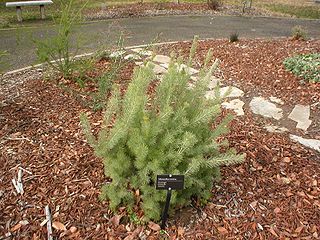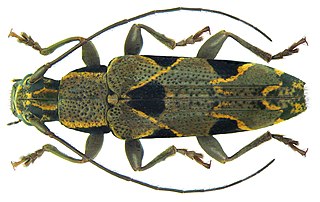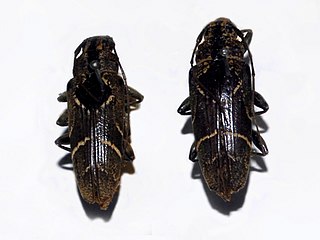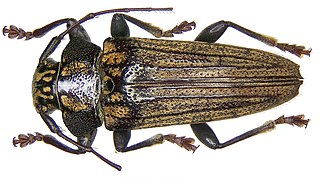
The medial lemniscus, also known as Reil's band or Reil's ribbon, is a large ascending bundle of heavily myelinated axons that decussate in the brainstem, specifically in the medulla oblongata. The medial lemniscus is formed by the crossings of the internal arcuate fibers. The internal arcuate fibers are composed of axons of nucleus gracilis and nucleus cuneatus. The axons of the nucleus gracilis and nucleus cuneatus in the medial lemniscus have cell bodies that lie contralaterally.

Adenanthos is a genus of Australian native shrubs in the flowering plant family Proteaceae. Variable in habit and leaf shape, it is the only genus in the family where solitary flowers are the norm. It was discovered in 1791, and formally published by Jacques Labillardière in 1805. The type species is Adenanthos cuneatus, and 33 species are recognised. The genus is placed in subfamily Proteoideae, and is held to be most closely related to several South African genera.

Isopogon cuneatus, commonly known as coneflower, is a species of plant in the family Proteaceae and is endemic to the south-west of Western Australia. It is a shrub with oblong to egg-shaped leaves with the narrower end towards the base, and flattened-spherical heads of glabrous pale to purplish pink flowers.

Adenanthos sericeus, commonly known as woolly bush, is a shrub native to the south coast of Western Australia. It has bright red but small and obscure flowers, and very soft, deeply divided, hairy leaves.

Eleutherodactylus cuneatus is a species of frog in the family Eleutherodactylidae endemic to Cuba. Its natural habitats are subtropical or tropical moist lowland forest, subtropical or tropical moist montane forest, subtropical or tropical moist shrubland, subtropical or tropical seasonally wet or flooded lowland grassland, rivers, arable land, pastureland, plantations, rural gardens, urban areas, heavily degraded former forest, and seasonally flooded agricultural land.

Ceanothus cuneatus is a species of flowering shrub known by the common names buckbrush and wedgeleaf ceanothus.

Ernest Charles Nelson's taxonomic arrangement of Adenanthos was the first modern-day arrangement of that plant genus. First published in his 1978 Brunonia article "A taxonomic revision of the genus Adenanthos (Proteaceae)", it superseded the arrangement of George Bentham, which had stood for over a hundred years. It was updated by Nelson in his 1995 treatment for the Flora of Australia series of monographs.

Adenanthos cuneatus, also known as coastal jugflower, flame bush, bridle bush and sweat bush, is a shrub of the family Proteaceae, native to the south coast of Western Australia. The French naturalist Jacques Labillardière originally described it in 1805. Within the genus Adenanthos, it lies in the section Adenanthos and is most closely related to A. stictus. A. cuneatus has hybridized with four other species of Adenanthos. Growing to 2 m high and wide, it is erect to prostrate in habit, with wedge-shaped lobed leaves covered in fine silvery hair. The single red flowers are insignificant, and appear all year, though especially in late spring. The reddish new growth occurs over the summer.
Adenanthos cacomorphus is a small shrub in the family Proteaceae. It is found in southwest Western Australia.
Adenanthos ileticos is a species of shrub in the family Proteaceae. It has roughly triangular, lobed leaves, and pale pink-red and cream, inconspicuous flowers. A rare species, it is known only from a single location in the south-west of Western Australia. It was discovered in 1968, and immediately brought into cultivation, but it would not be formally published and named until a decade later.

Atractosteus is a genus of gars in the family Lepisosteidae, with three species.
George Bentham's taxonomic arrangement of Adenanthos was the first comprehensive taxonomic arrangement of that plant genus. It was published in 1870 in his landmark flora of Australia, Flora Australiensis. It would stand for over a hundred years before being superseded by the 1978 arrangement of Ernest Charles Nelson.

Adenanthos cuneatus is a shrub of the family Proteaceae, native to the south coast of Western Australia. It was described by Alex George in 1974.
Adenanthos ellipticus, commonly known as the oval-leaf adenanthos, is a flowering plant from the family Proteaceae that is endemic to Western Australia where it is considered to be Declared Rare Flora.

Tmesisternini is a tribe of beetles in the subfamily Lamiinae containing the following genera:

Tmesisternus is a genus of longhorn beetles belonging to the family Cerambycidae, subfamily Lamiinae.
Tmesisternus jaspideus is a species of beetle in the family Cerambycidae. It was described by Jean Baptiste Boisduval in 1835.
Tmesisternus schaumii is a species of beetle in the family Cerambycidae. It was described by Francis Polkinghorne Pascoe in 1867. It is known from Moluccas, Australia, and the Solomon Islands.

Tmesisternus venatus is a species of beetle in the family Cerambycidae. It was described by James Thomson in 1864.

Neocapsus cuneatus is a species of plant bug in the family Miridae. It is found in Central America and North America.













